Translated by Bethszabee Garner
The Arab World Institute pays tribute to Mehdi Qotbi, an emblematic figure of Franco-Moroccan contemporary art. His works, oscillating between Arabic calligraphy and abstraction, trace a path where tradition and modernity engage in a loving dialogue. The exhibition features paintings, ceramics and tapestries. Drawing on his roots, the artist weaves an art that transcends borders, inviting the visitor to celebrate the richness of cultural diversity.

Désirée de Lamarzelle: Your works are inspired by the zellige tiles and carpets of your childhood. What role does childhood play in an artist's life?
Mehdi Qotbi: Childhood is the foundation. What marks us at that age is imprinted on us, guiding our actions. I think of my mother, knotting carpets with an unconscious abstraction. This skill, long before it was celebrated in the West, carried modernity within it. In this sense, I believe that we must pay tribute to these Moroccan women, to these mothers who, without knowing it, embodied modernity, long before it was celebrated by recognized artists. When I paint, I think of these knots, the colors and patterns that have shaped my gaze. This constitutes an inestimable richness of intimacy with words that shines through in my art, where each stroke is a quest for beauty and meaning, a tribute to the poetry that nourishes my gaze.
Désirée de Lamarzelle: Do your paintings form a universal language?
M.Q.: Dominique Bozo said that my works offer a dual reading: a distant abstraction and, up close, a culture and a history through signs. It is a universal language where two cultures meet, transcending borders, and offering a vision of this intertwining. It is a never-ending book, where each new canvas opens a new chapter, bringing a nuance, a new emotion. Each one is distinguished by its own identity, bearing witness to a continuity where nothing is repeated, but everything completes each other.
Désirée de Lamarzelle: You seem to weave a link with your culture through your pictorial gesture.
M.Q.: I learned from one of my teachers that after the Beaux Arts, you had to become yourself. In France, at the end of the 60s, I distanced myself from my roots in order to find myself better. My art has become a means of reconnecting with these visual writings, a return to my intimate history, like the knots that my mother wove in carpets.
Désirée de Lamarzelle: A language in which you nevertheless cover the tracks...
M.Q.: I don't like the idea of “covering the tracks”, because it implies a calculation. My work is more of a linguistic abstraction, a kind of spontaneity that goes back to my mother's gestures. When I start a work, everything starts from an emotion, then I navigate between reflection and adaptation. I always start with a pencil, the brush comes later.
Désirée de Lamarzelle: What place does literature occupy in your work?
M.Q.: I discovered the French language a little late in life and it immediately captivated me. It is a language that has shaped me, that has made me the person I am today. I live it intensely, day and night, it feeds my dreams. It is poets such as Octavio Paz, Yves Bonne-foy and Aragon who have helped me to grasp its depth. This intimacy with words shines through in my art, where each stroke is a quest for beauty and meaning, a tribute to the poetry that nourishes my gaze.

Désirée de Lamarzelle: You have an almost childlike passion in your approach to art...
M.Q.: You are touching on something fundamental: passion. Like children, artists have this ability to let themselves be carried away without restraint. Perhaps this part of childhood, this flame, pushes us to feel emotions, pain and joy with a particular intensity, almost tenfold. A passion that inhabits us, that follows us, and that perhaps represents this part of childhood that we refuse to leave behind.
Désirée de Lamarzelle: Your beginnings were marked by a decisive encounter with Jilali Gharbaoui.
M.Q.: I met the man before discovering his painting, and he was a person of exceptional generosity. He was one of the first to believe in me, to reach out to me. He even acted as an intermediary to sell my first paintings, which enabled me to buy all the equipment I needed to pursue my art: my first blank canvases, my brushes, paint tubes…
Désirée de Lamarzelle: Did you always know that you wanted to be a painter?
M.Q.: Yes, because I didn't know how to do anything else. It was the only thing that made me want to believe in myself, even in difficult moments, when I was faced with indifference or lack of resources. I come from a modest background, and this experience shaped me, pushing me to reach out to others, to catch their attention. An almost vital necessity.
Désirée de Lamarzelle: Coming from this modest background, it was not easy to choose to become an artist.
M.Q.: I am a deeply religious person, and my faith has undoubtedly given me a humanity that I might never have developed otherwise. I know the value of the few francs that allowed me to survive when I arrived in France. This experience of poverty is ingrained in me. I wouldn't change anything about my journey; it's what has shaped me.

Désirée de Lamarzelle: Can we talk about a work of writing nourished by spirituality?
M.Q.: When I arrived in France, Benedictines welcomed me and passed on their spirituality and rigor to me. This imbues my work, like writing marked by spiritual depth, like illuminated manuscripts. It is a dialogue between East and West.
Désirée de Lamarzelle: You were a teacher. What advice did you give your students?
M.Q.: During my thirty years of teaching, I always told my students that learning art is above all a way of discovering who you are. Everyone has their own language, and you should never compare yourself to others. Be yourself, and forget the constraints. The important thing is to remain true to who you are, without letting yourself be restricted.
Désirée de Lamarzelle: As president of the Fondation nationale des musées du Maroc, what is your mission?
M.Q.: I am extremely grateful to His Majesty the King, who has given me the opportunity to share my passion for art with the Moroccan public. Exhibiting works by Picasso or Delacroix in Morocco was a dream. My dual Franco-Moroccan culture nurtures this vision where art is a vehicle for peace and humanity.







